
The Babuyan Islands, also known as the Babuyan Group of Islands, is an archipelago in the Philippines, located in the Luzon Strait north of the main island of Luzon and south of Taiwan via Bashi Channel to Luzon Strait. The archipelago consists of five major islands and their surrounding smaller islands. These main islands are, counterclockwise starting from northeast, Babuyan, Calayan, Dalupiri, Fuga, and Camiguin. The Babuyan Islands are separated from Luzon by the Babuyan Channel, and from the province of Batanes to the north by the Balintang Channel.
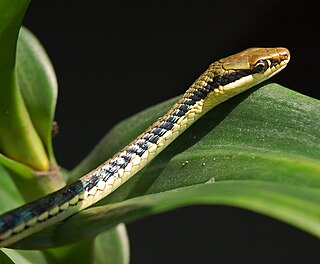
Dendrelaphis pictus is a species of snake found in Southeast Asia and India.

Gonyosoma prasinum is a species of colubrid snake found in Asia.

Lycodon aulicus, commonly known as the Indian wolf snake, is a species of nonvenomous snake found in South Asia and Southeast Asia. Early naturalists have suggested its resemblance to the venomous common krait as an instance of Batesian mimicry.
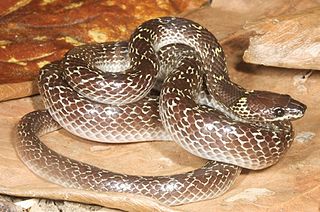
Lycodon capucinus, also known as the Oriental wolf snake, is a species of colubrid snake, which is commonly found in the Indo-Australian Archipelago. Named after their enlarged front teeth, which gives them a muzzled appearance similar to canines, it also makes the snout somewhat more squarish than other snakes.

Lycodon jara, commonly known as the twin-spotted wolf snake, is a species of colubrid snake. It is endemic to Asia.

Lycodon striatus, commonly known as the northern wolf snake or the barred wolf snake, is a species of nonvenomous colubrid snake from southern Asia.
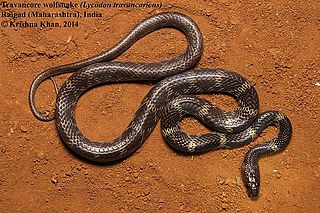
Lycodon travancoricus, commonly known as the Travancore wolf snake, is a species of colubrid snake endemic to southwestern India.
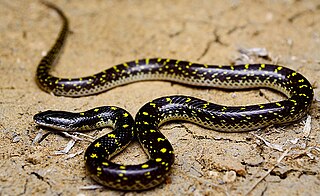
Lycodon flavomaculatus, commonly called the yellow-spotted wolf snake, is a species of colubrid snake found in the Western Ghats of India.

Lycodon laoensis, commonly known as the Laotian wolf snake, is a species of nonvenomous colubrid snake endemic to Asia.
Lycodon mackinnoni, commonly known as the Himalayan wolf snake, Mackinnon's wolf snake, or the Mussoorie wolf snake, is a species of snake in the family Colubridae. The species is endemic to Western Himalaya.
Lycodon tiwarii, commonly known as the Andaman wolf snake and Tiwari's wolf snake, is a species of snake in the family Colubridae. The species is native to the Andaman Islands and Nicobar Islands of India.

Lycodon is a genus of colubrid snakes, commonly known as wolf snakes. The New Latin name Lycodon is derived from the Greek words λύκος (lykos) meaning wolf and οδόν (odon) meaning tooth, and refers to the fang-like anterior maxillary and mandibular teeth. They are nonvenomous, but many members of this genus strongly resemble the venomous kraits in appearance, an example of Batesian mimicry.
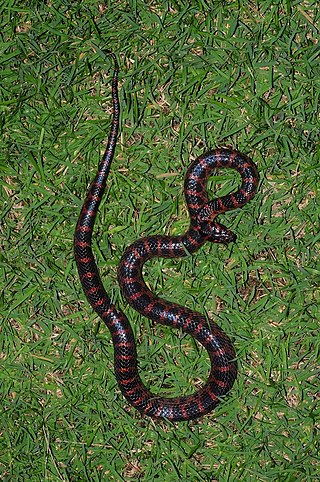
Lycodon rufozonatus is a species of snake in the family Colubridae. The species is native to East Asia. It is medium-sized, nocturnal, and is considered non-venomous. Two subspecies are recognised, one of which, L. r. walli, is restricted to the Ryukyu Archipelago.
Lycodon alcalai, also known commonly as Alcala's wolf snake, is a species of snake in the family Colubridae. The species is endemic to the Philippines.
Lycodon chrysoprateros, also known as Ross' wolf snake, is a species of colubrid snake found on the island of Dalupiri in the Philippines.
Lycodon solivagus, also known as the common wolf snake, is a species of colubrid snake found on Luzon Island in the Philippines.
Lycodon cardamomensis, also known as the Cardamom Mountains wolf snake, is a species of nonvenomous colubrid snake found in south-western Cambodia and eastern Thailand.
Lycodon cavernicolus, also known as Gua Wang Burma wolf snake, is a species of colubrid snake found in peninsular Malaysia. It was first described in 2014.

Lycodon ruhstrati, also known as Ruhstrat's wolf snake, the mountain wolf snake, or the Formosa wolf snake, is a species of non-venomous colubrid snake found in Taiwan, southern and eastern China, and northern Vietnam.













